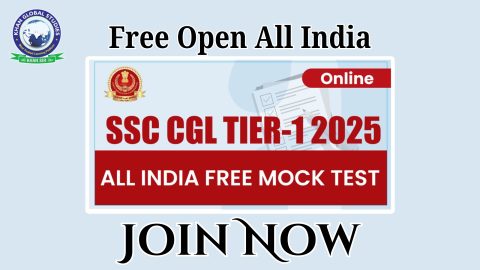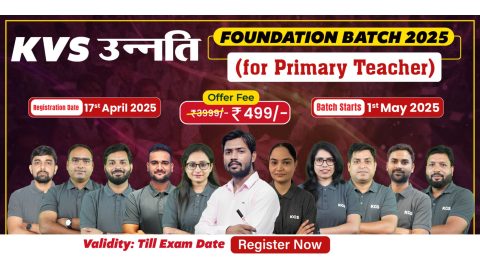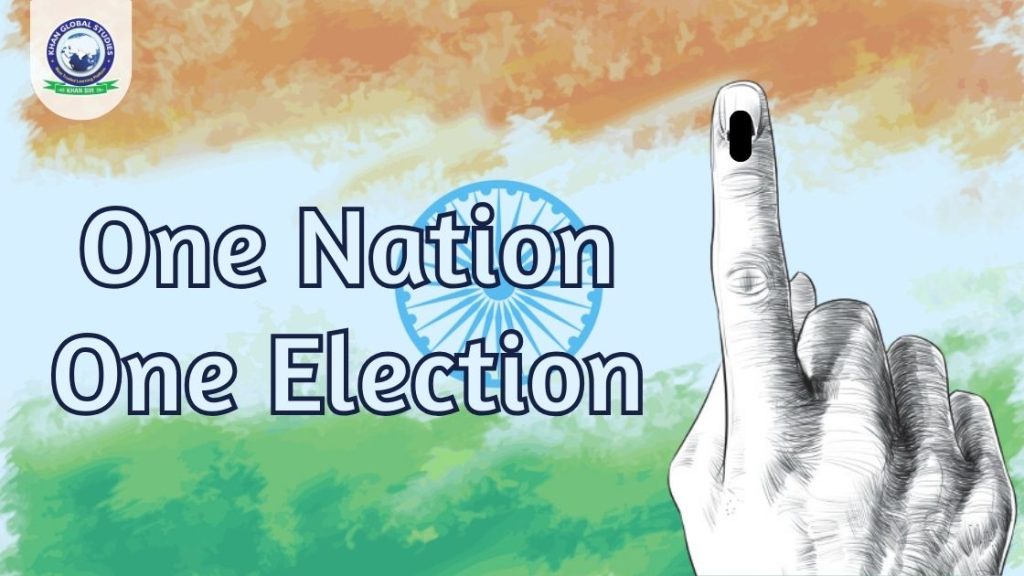One Nation, One Election is one of the important reforms included in the agenda of the outgoing central government. Former President of India Ramnath Kovind discussed it as one of the reforms proposed by the government in his address to Parliament in January 2018. He said that there is concern among the citizens regarding the continuous elections in some parts of the country. This hurts the economy and development. Prime Minister Narendra Modi has also been vocal about the desirability of holding a single election across the country. So this is not a sudden idea but it has been discussed.
One Nation, One Election Background
After independence, simultaneous elections were held for the Lok Sabha and state assemblies. This was true for the elections of 1952, 1957, 1962 and 1967. However, it was discontinued because some state assemblies had already been dissolved for various reasons in 1968–69.
At present, elections for state assemblies and Lok Sabha are held separately. This happens when the five-year term of the current government either ends or the assembly is dissolved. The terms of the Legislative Assemblies and the Lok Sabha may or may not be concurrent with each other. For example, Rajasthan will hold elections in late 2018, while Tamil Nadu will hold elections only in 2021.
- On average 5-7 assembly elections are held in a year. Due to the problems arising from this, the Election Commission suggested making a system by which elections for the State Assembly and Lok Sabha could be held simultaneously.
- In 1999, the Law Commission headed by Justice Reddy also recommended holding simultaneous elections. In 2015, the 79th Report of the Parliamentary Standing Committee reiterated its support for holding simultaneous elections.
- The idea of holding simultaneous elections was re-introduced by Prime Minister Modi in 2016. The ruling Bharatiya Janata Party has since made a strong argument for holding simultaneous elections.
- A working paper on simultaneous elections was prepared by NITI Aayog in 2017. Even the Law Commission came up with a working paper in 2018 stating that the possibility of holding simultaneous elections would require at least five constitutional changes.
Recently, BJP leader Shri Naqvi has called upon political parties to consider holding elections together. However many opposition parties still oppose the idea.
What is the central idea behind ‘One Nation, One Election’?
- The central idea behind ‘One Nation, One Election’ is to coordinate all state assembly elections with Lok Sabha elections to reduce the frequency of elections across the country.
- This concept was prevalent in the country till the year 1967, but due to various reasons like defection, dismissal and dissolution of the government, this system was disrupted.
- This cycle was broken for the first time in the year 1959 when the Center invoked Article 356 to dismiss the then-Kerala government.
- After 1960, many assemblies were dissolved due to defection and counter-defection among political parties, which ultimately resulted in separate elections for the Lok Sabha and state assemblies.
- Currently, assembly elections are held along with Lok Sabha elections in the states of Arunachal Pradesh, Sikkim, Andhra Pradesh and Odisha.
- The idea of holding simultaneous elections was mooted in 1999 by B.P. Had supported. The Law Commission headed by Jeevan Reddy had also done so.
What are the benefits of ‘One Nation, One Election’?
1. Focused Governance: This enables the government to focus on governance after the elections are over. At present, elections are held at least every three months in some parts of the country. The entire attention of the country is focused on these elections. From the Prime Minister to Union Ministers, from Chief Ministers to Ministers of State and from MPs, MLAs to Panchayat members – everyone enters these elections with full dedication because no one wants to lose.
- Different levels of administrative inefficiency arise at different levels of administration. This hurts India’s growth prospects.
2. Continuity of Policy Decisions: The Model Code of Conduct comes into force as soon as the elections are announced by the Election Commission (EC). Due to MCC, no new policy decisions can be taken during the election period. This leads to delays in major policy decisions at all levels – Centre, State and local bodies.
- Even when no new policy decisions are required, implementation of projects gets derailed during the election period as the political executive as well as government officials remain busy with election-related duties, neglecting routine administration.
3. Reduction in Cost of Elections: One of the main reasons for political corruption is frequent elections. A huge amount of money has to be raised in every election. By holding simultaneous elections, the election expenses of political parties can be significantly reduced. This will avoid duplication of fundraising. This will also free the public and the business community from the pressure of repeated election donations.
- According to a report, Rs 60,000 crore was spent on the 2019 Lok Sabha elections.
- Apart from this, if elections are held simultaneously then the expenditure of the Election Commission can also be reduced.
- Undoubtedly, the Election Commission will have to invest a huge amount initially to set up the necessary infrastructure to conduct the elections on the concept of ‘one country, one election’.
- Additionally, the same voter list can be used for all elections. This will save a huge amount of time and money spent on updating the voter list.
- This will also make it easier for the citizens as they will be free from the worry of their name missing from the voter list after enrolment.
4. Lack of Deployment of Security Forces: A large number of policemen and paramilitary forces are deployed to conduct the elections peacefully. This involves massive re-planning, which involves huge costs. It also distracts key law enforcement personnel from their important duties. The need for such deployment can be reduced by holding simultaneous elections.
5. Eliminating Horse-Trading: Holding elections on a staggered basis can potentially reduce horse-trading by elected representatives, which remains a concern despite the implementation of anti-defection laws. Holding elections at fixed intervals may prove difficult for them to change parties or form alliances for personal gain.
6. Reduction in ‘Freebies’ and improvement in the Financial condition of the State: Due to frequent elections, governments make some policy decisions to woo voters in every election. Although it cannot be stopped completely, the frequency of governments announcing freebies will reduce. Due to continuous elections, such a situation has arisen that many state governments are victims of financial crisis. Reducing the number of elections may improve their financial condition.
Cons of One Nation One Election
Even if simultaneous elections become a reality, such a reform has several shortcomings. Many opposition political parties have made their opinion clear against this reform.
- Holding simultaneous elections can affect the voters’ decisions. Voters will pay more attention to national issues rather than local issues.
- Due to strong central politics, regional parties will not be able to raise regional and local issues properly.
- This will promote the tendency of centralization in Indian politics and politics.
- Holding simultaneous elections can harm the accountability of the government towards the public. Due to frequent elections, control over the government and legislature is maintained, which is not the case if elections are held simultaneously.
- To hold elections simultaneously, elections will have to be postponed in some states. This can be done only through President’s rule which will be problematic for democracy and federalism.
- Although holding simultaneous elections will reduce the expenditure of governments, it will not have any impact on the expenditure of political parties, which is one of the reasons for corruption in politics.
- Only the constructive vote of no confidence required for constitutional amendment can tamper with the ethos of parliamentary democracy.
- Although the Election Commission has said that holding simultaneous elections is possible, it will be a major achievement.
Major challenges related to ONOE
1. Problem of Viability: Articles 83(2) and 172 of the Constitution respectively provide that the tenure of the Lok Sabha and State Legislative Assemblies shall be five years unless sooner dissolved. But circumstances may arise (circumstances described in Article 356) where the Assemblies may be dissolved even before the expiry of their terms. Thus, there are some serious questions related to ONOE, such as:
- What will happen if the central or state government falls in the middle of its tenure?
- In such a situation, will there be re-elections in every state or will President’s rule be imposed?
2. Logistical Challenges: This will create logistical challenges in terms of the availability and security of electronic voting machines, personnel and other resources. The Election Commission may face difficulties in handling such a big exercise.
3. Against the idea of Federalism: The idea of ONOE is not in keeping with the concept and spirit of ‘Federalism’ as it is founded on the assumption that the entire nation is ‘one’, which contradicts the provision of Article 1 where India is. It has been seen as a ‘Union of States’.
4. Legal Challenges: Justice B.S. The Law Commission headed by Chauhan had said in its report that it is not possible to hold simultaneous elections under the current structure of the Constitution.
- It said holding simultaneous elections would require appropriate amendments to the Constitution, the Representation of the People Act 1951 and the rules of procedure of the Lok Sabha and the Assemblies.
- The Commission had also recommended obtaining ratification from at least 50% of the states for this, which is no easy task.
5. Eclipse over Regional Interests: The current pattern of frequent elections can be seen as an advantage in democracy as it gives voters a chance to make their voices heard again and again. Since the underlying issues of national and state elections differ, the existing framework prevents the mixing of issues, thereby ensuring greater accountability.
- A study conducted by the IDFC Institute in 2015 found that holding simultaneous elections would create a 77% chance that the winning political party or alliance would win both the Lok Sabha and the state assemblies. This will meet the specific demands and needs of each state.
6. Likely not to be Cost-Effective: Various estimates by the Election Commission, NITI Aayog etc. suggest that the cost of conducting all state and parliamentary elections in a five-year cycle comes to Rs 10 per voter per year. The NITI Aayog report also said that if simultaneous elections are held, the expenditure would be Rs 5 per voter per year.
- Holding simultaneous elections would require the deployment of a large number of EVMs and VVPATs, which would increase initial costs in the short term. Thus, amending the Constitution to save Rs 5 per voter per year may not be considered a very good idea.
7. Election spending is not necessarily a Negative Phenomenon: economic research shows that election spending by political parties and candidates can benefit the economy and government tax revenues by boosting private consumption and acting as catalysts/stimulants.
Road Ahead
- There should be a consensus among all political parties and states on the need and feasibility of simultaneous elections. This can be done through dialogue, consultation and deliberations among various stakeholders.
- To make simultaneous elections possible, the Constitution, the Representation of the People Act 1951 and the rules of procedure of the Lok Sabha and state legislatures will have to be amended.
- For this, a two-thirds majority in both houses of Parliament and approval of at least half the states will be required.
- Holding simultaneous elections will require investment in necessary infrastructure and technology, such as Electronic Voting Machines (EVMs), Voter-Verified Paper Audit Trail (VVPAT) machines, polling stations, security personnel, etc.
- The tenure of the Lok Sabha and State Assemblies will either be extended or reduced through constitutional amendment to align the electoral cycles of the Lok Sabha and State Assemblies.
- A legal framework will have to be established to deal with situations like no-confidence motions, premature dissolution of assemblies, hung parliament etc.
- It can be organized twice a year so that if the assembly of a state is dissolved prematurely, re-elections can be held in that state in the next cycle.
- To create awareness among voters about the benefits and challenges of holding simultaneous elections and ensure that they can exercise their franchise without confusion or inconvenience.
Conclusion
The government should not rush to implement ONOE. It should invite additional study, evaluation of data and feedback from voters, opposition party leaders and local parties on how to implement the concept. Therefore, the entire country should be given a chance to decide whether there is a need to implement ‘One Nation, One Election’ or not.
Must Read:
Indian Constitution: History, Overview and Interesting Facts




